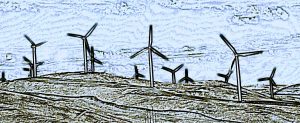 RES-Americas proposes to install 38 wind-energy turbines on ridge tops in northern Lewis County, with part of the infrastructure in Thurston County. Like National Audubon Society, the Black Hills Audubon Society supports wind-energy projects as long as the direct damage to birds from the turbines is appropriately minimized and mitigated.
RES-Americas proposes to install 38 wind-energy turbines on ridge tops in northern Lewis County, with part of the infrastructure in Thurston County. Like National Audubon Society, the Black Hills Audubon Society supports wind-energy projects as long as the direct damage to birds from the turbines is appropriately minimized and mitigated.
The public is invited to comment on the scope of Environmental Impact Statements (EIS) by both Lewis County and the U.S. Fish and Wildlife Service. Your input is important to help these agencies better evaluate the potential impact of this wind-energy project on the environment, especially protected Marbled Murrelets, Bald Eagles, Golden Eagles, and other species of concern. Often, officials or staff members really want our comments because public input empowers them to address wildlife conservation issues. You do not need to live in either Lewis or Thurston Ct. to submit Comments.
The deadlines for Comments are very soon:
For the Lewis County EIS: Send Comments by Thursday, May 31 (5 p.m.), via email to karen.witherspoon@nulllewiscountywa.gov or by postal mail to Lee Napier, Director, Lewis County Community Development Dept., 2025 NE Kresky Ave., Chehalis, WA 98532.
For the USFWS EIS: Send Comments By Monday, June 4 to USFWS via email to wfwocomments@nullfws.gov (include “Skookumchuck Wind” in the subject line) or by postal mail to U.S. Fish and Wildlife Service, c/o Mark Ostwald, 510 Desmond Dr. SE, Suite 102, Lacey, WA 98503.
The following are points you could make:
- The EIS should include a more accurate estimate of the level of “take,” i.e. the number of direct kills of Marbled Murrelets, Bald Eagles, and Golden Eagles, Bats, and migratory avian species. Especially important for the USFWS EIS.
- RES’s radar study of Marbled Murrelets (ABR 2015) assumes an artificially high avoidance rate based on surrogate species whose flight patterns and behaviors are extremely dissimilar to the murrelets—a dissimilarity that may lead to gross underestimation of the murrelet mortality rate.
- The EIS should analyze the effect on Marbled Murrelets of curtailing wind turbine operation during the species’ peak commute times between their marine foraging areas and nest sites (from one hour before sunrise to two hours after official sunrise and from one hour before official sunset to one hour after official sunset) during the breeding season (April 1 through September 23).
- The five turbines to be sited closest to known nest sites can be relocated or eliminated to reduce impact on Marbled Murrelets.
- The EIS should examine why the level of take proposed by RES-Americas is so high—4 to 5 Bald Eagles and 1 Golden Eagle per year for the 30-55 years of operation. RES-Americas has a technology to detect approaching eagles and stop the turbines, but does not plan to implement this technology during the first two years of operation or until they approach the “take” limit that will be set USFWS.
- The EIS should include analysis of the impacts of the turbines and related infrastructure on the following avian and bat species:
- Marbled Murrelets (state endangered, federally threatened)
- Bald Eagles (federal species of concern)
- Golden Eagles (state species of concern)
- Peregrine Falcon (federal species of concern, state sensitive species)
- Northern Goshawk (state candidate species)
- Olive-sided Flycatcher (federal species of concern)
- Pileated Woodpecker (state candidate species)
- Vaux’s Swift (state candidate species)
- Townsend’s Big-Eared Bat (state candidate species)
- Long-eared Myotis (federal species of concern)
- Long-legged Myotis (federal species of concern)
More background and Talking Points on the effects on birds of the Skookumchuck Wind Energy Project
More information on this project from Lewis County Community Development







